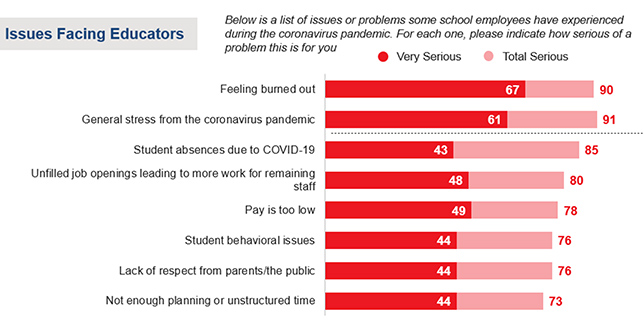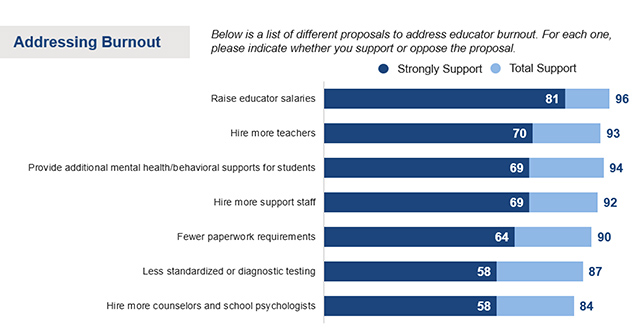Pandemic Impact
NEA Survey Shows Big Jump in Educators Planning to Leave Teaching Sooner Than Planned
- By Kristal Kuykendall
- 02/01/22
The National Education Association, the nation’s largest union representing nearly 3 million educators, on Tuesday released its latest survey conducted last month showing 90% of educators responded that burnout is a “serious problem” for them.
Also notable: more than half, 55%, of the 3,621 educators surveyed said the pandemic has made them “more likely to retire or leave education earlier than planned” — representing a significant increase from the 37% with this response to the same question in an August 2021 NEA survey.
The polling firm, GBAO Strategies, said the 55% of teachers planning to exit education sooner than planned held true for respondents across all age groups and years of experience. The survey included questions about NEA members’ opinions on the biggest issues in public education since the start of the pandemic, including vaccination status, mask and mitigation strategies, staff outages and shortages and their impacts on teachers, and student outages.
Among those planning to leave teaching or retire sooner is a disproportionately high percentage of Black (62%) and Hispanic (59%) educators, already underrepresented in the teaching profession, NEA said on a blog post discussing the new survey.
While 94% of educators reported their schools were fully open for in-person learning, the few respondents saying their schools were fully in-person said the cause is primarily staff shortages, according to the survey report from GBAO Statistics.
“This is a five-alarm crisis,” said NEA President Becky Pringle. “We are facing an exodus as more than half of our nation’s teachers and other school staff are now indicating they will be leaving education sooner than planned. If we’re serious about getting every child the support they need to thrive, our elected leaders across the nation need to address this crisis now.”

Although teacher shortages predate the pandemic — there have long been shortages for substitute teachers and for “hard-to-staff” subjects such as math, science, special education, and bilingual education, NEA said — the number of unfilled teacher positions has grown in the past two years as staff shortages widened to include other positions such as bus drivers, school nurses, and food service workers.
Nationally, the ratio of hires to job openings in the education sector has reached new lows as the 2021-22 school year started, NEA noted, and currently stands at 0.57 hires for every open position, according to BLS’s Job Openings and Labor Turnover Survey.
Key findings from the survey, Jan. 14–24, 2022, include:
On School Staffing:
- Three-fourths (74%) of respondents said they've had to fill in for colleagues or take other duties due to staff shortages.
- 80% of those surveyed reported that unfilled job openings have led to more work obligations for the educators who remain.
On Teacher Burnout:
- 90% of members said feeling burned out is a serious problem (67% very serious).
- To address educator burnout, raising educator salaries received the strongest support (96% support, 81% strongly support), followed by providing additional mental health support for students (94% support), hiring more teachers (93%), hiring more support staff (92%), and less paperwork (90%).
- 91% reported that pandemic-related stress is a serious problem for educators.
On the Impact of COVID on Schools:
- Even as the Omicron variant was peaking, nearly all respondents reported their schools (94%) have been fully open for in-person learning.
- Of the 6% of respondents who reported not being in-person, most attributed closings to a combination of:
- Teacher and substitute shortages due to COVID-19 exposure (62%)
- Too many students are out of school due to COVID-19 exposure (42%)
- Support staff shortages due to COVID-19 exposure (28%).
- Ventilation remains a key area to address, with 95% of respondents reporting a desire for improved ventilation in schools.
Just over a third reported having improved ventilation in their schools and only 28% felt their school's ventilation system provides them with enough protection — but that number is lower when considering responses from educators at schools primarily serving students of color and economically disadvantaged students, where only 21% of respondents believed their schools had adequate ventilation.
More than a third, 35%, of educators said mask and mitigation policies have been eased since the beginning of the school year.
“Throughout this pandemic, America’s educators have shown us how committed they are to helping their students thrive,” Pringle said. “But, as our new survey shows, after persevering through the hardest school years in memory, America’s educators are exhausted and increasingly burned out. School staffing shortages are not new, but what we are seeing now, is an unprecedented staffing crisis across every job category.”
The survey also asked educators to indicate their feelings about potential solutions recently proposed by the NEA that could help address the staff shortage crisis; respondents registered their support for the proposals as follows: raising educator salaries (96%), hiring more teachers (93%), providing additional mental health and behavioral supports for students (94%), hiring more support staff (92%), reducing paperwork requirements (90%), reducing standardized or diagnostic testing (87%), and hiring more counselors and school psychologists (84%).

Download the full survey results on the NEA website.
About the Author
Kristal Kuykendall is editor, 1105 Media Education Group. She can
be reached at [email protected].